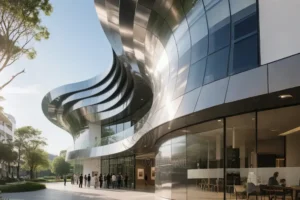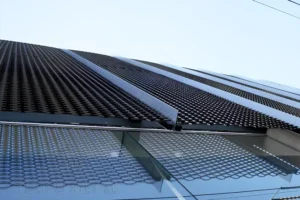The use of aluminum ceilings has become a leading innovation in modern construction, regarding interior building design. For many years, ceilings were mostly being passive with most people considering them as things that are simply there to be there. Nonetheless, with the new materials and technologies crystallizing, aluminum ceilings have become important architectural features we can integrate aesthetics with functionality. They have combined structure and flexibility providing solutions to a number of building needs whether commercial, residential or industrial.
The Rise of Aluminum Ceilings
One reason aluminum ceilings are popularizing and taking more space in the market is their excellent combination of lightweight and strong properties. In contrast to the ceiling materials of the past, aluminum ceiling panels are incredibly strong while not adding much weight to the entire structure. This is great for large buildings or buildings that are going to be strictly weight restrictive. Generally, aluminum does not corrode and therefore is perfect for indoor use and even such exterior applications as high humidity and coastal regions where other materials would rust faster.
Another often overlooked feature of aluminum ceilings is their customization potential. Whether crafting a sleek, minimalist corporate atmosphere or a visually captivating residential area, aluminum ceilings offer endless design possibilities. From open-cell structures that enhance airflow to elaborate perforated patterns that manage acoustics, the opportunities are vast.
Additionally, sustainability considerations are gaining prominence in construction. Since aluminum is a material that can be recycled in a lot of different ways, it has become a choice that is good for the environment and cheap.
In conclusion, aluminum ceilings provide solutions that balance form, function, and sustainability, transforming spaces in previously unimaginable ways.
Different Aluminum Ceiling Types
Aluminum Ceiling Tile
A rectangular panel traditionally composed of false ceilings is known as ceiling tiles. These ceiling tiles are among the most used aluminum ceiling solutions because they are quite practical and indeed very easy to use.

Pros:
Simple to Fit: Puzzle-meth tiles can be laid quickly within even sophisticated internal layout ceilings due to their lightweight and modular structure.
Customizable: Offering an extensive range of designs and finishes, ceiling tiles are appropriate for use by architects and designers who wish to meet popular aesthetics.
Durability: These tiles are moisture-proof, corrodible proof and fire-resistant thus making an economical solution for any building construction.
Cons:
Pricing: Depending on the material of tiles and their dimensions, size, and customization, ceiling tiles may be quite pricey, particularly for large projects.
Look preferences: The grid-formed visual may not be pleasing to those who want a more clean-lined ceiling.
Baffle Ceilings
Aluminum baffle ceiling consists of elongated and flat rectangles that run perpendicular to the ceiling and hang vertically, therefore, introducing a striking and complex design. These types of panels can both be applied in lines or rows as well as spread out through the room depending on the design requirements. Such gaps provide for differences in the intensity of light and movement of air within the room. This ceiling design adds up and elongates the rooms giving them a contemporary and open finish. Baffle ceilings are appropriate, particularly in modern and or minimal designs, where clean edges and simplistic geometric shapes are mandatory.

Pros:
Acoustic Performance: They are good at noise management which is why baffle ceilings are preferred in commercial and public places like airports and offices.
Ventilation & Lighting: Such a system is more open provides better ventilation and also accommodates lighting fixtures effectively.
Customization: Baffle ceilings come in various colors, materials, and designs therefore providing baffle ceilings with general design flexibility to anyone.
Cons:
Installation Cost: Because baffle ceilings have a more complex design concept, the cost incurred in the fixing of baffle ceilings is usually higher than that of other types of ceiling systems.
Limited Concealment: Baffle ceilings do not mask up devices such as duct and wiring, these types of ceilings do not have complete coverage systems.
Open Cell Ceilings
Aluminum open cell ceilings feature a grid-like structure that creates an arrangement of open voids, enhancing both visual and functional aspects of a space. These ceilings provide a striking interplay of light and shadow, adding dimension to large areas like lobbies, exhibition halls, or retail spaces. Their acoustic properties make them effective at reducing noise by diffusing sound waves, ideal for environments like offices and conference rooms. Additionally, their lightweight, modular design ensures easy installation and access to the plenum, offering both cost and maintenance efficiency.
Pros:
Airflow and Lighting: The open structure allows for better ventilation and natural light penetration, ideal for large public spaces like shopping centers.
Custom Design: Available in various colors and finishes, open-cell ceilings offer flexibility for different aesthetic needs.
Cons:
Limited Coverage: Open cell ceilings do not fully cover utilities, leaving mechanical elements visible.
Sound Insulation: They provide less soundproofing compared to more closed ceiling systems.
Mesh Ceilings
Aluminum mesh ceilings are great in modern architecture since they are transparent, strong, and flexible at the same time. These ceilings usually consist of metal sheets that feature cutouts or a mesh layout that is semi-opaque allowing for the creation of interesting visuals. The open structure allows for the diffusion of light and circulation of air and is hence suitable for places that require lighting and ventilation. Most places that ask for more foot traffic such as airports, train or bus stations, and shopping malls are decorated with mesh ceilings which are good-looking and practical.

Pros:
Ventilation: The open grid design promotes better air circulation.
Aesthetics: Adds a sleek, modern feel to large spaces.
Accessibility: Easy access to utilities like wiring and ductwork.
Cons:
Concealment: Less effective at hiding utilities compared to solid ceilings.
Curved Acoustic Ceiling
The aluminum curved ceilings belong to the culture of modern architecture and are very well practiced anywhere since they make an interior more decorative. They are especially and very efficiently engaged in the enhancement of movement and volume in modern structures such as the theaters, galleries or commercial establishments.

Pros:
Aesthetic Appeal: Curved ceilings have an addition of beautiful and long sweeping lines to the buildings which normal angle ceilings do not have.
Acoustic Benefits: These might assist in achieving even sound within the space in open areas.
Customizable Design: Curved and different finishes that will accommodate the designs are provided.
Cons:
Complex Installation: Due to the challenging complexity, installation duration, and costs may increase on the median.
Structural Requirements: More support is likely to be inadequate as curved ceiling structure builders will need more material to construct.
Aluminium Strip False Ceiling
The long, narrow aluminum panels that makeup aluminum strip ceilings create clean, linear designs. Because of its sleek and minimalist appearance and advantages in both aesthetics and functionality, this kind of ceiling is common in contemporary architecture.

Pros:
Minimalistic Design: Ideal for contemporary spaces, providing a streamlined, modern look.
Ease of Maintenance: These can be easily cleaned and maintained owing to the panel surface and structure.
Flexibility: There are no restrictions concerning the panel length, width, or color, as they can be customized easily.
Cons:
Limited Coverage: Not suitable for projects requiring full ceiling coverage as gaps between panels may expose utilities.
Acoustics: Offers limited sound absorption compared to other ceiling types.
Blade Ceilings
Blade ceilings consist of slender, vertically oriented panels that create a sleek, minimalist look, often used to emphasize height and space in modern architectural designs.

Pros:
Visual Impact: Adds depth and definition, especially in tall spaces like lobbies or public areas.
Ventilation: Allows for airflow and can easily integrate with lighting and HVAC systems.
Customization: Available in various lengths, materials, and finishes to match different design themes.
Cons:
Acoustic Limitations: Limited sound absorption compared to other ceiling types.
Complex Installation: May require specialized installation, increasing labor costs.
Corrugated Ceilings
Panels that are wavy and undulating give corrugated ceilings their bold, industrial look. These Corrugated Ceilings add a dynamic element to the design of the ceiling and are frequently found in warehouse, retail, or commercial settings.
Pros:
Durability: They are suitable for long-term use because they are highly resistant to weathering, corrosion, and damage.
Aesthetic Attraction: is ideal for modern and industrial-themed areas because it adds texture and interest to the visual.
Lightweight: Reduced labor and installation costs due to its ease of handling and installation.
Cons:
Limited Absorption of Sound: not the best choice for settings where precise sound control is essential.
Restrictions on Design: In applications requiring more complex or formal design, less adaptable.
Factors to Consider When Choosing a Ceiling Type
Choosing the right kind of ceiling is essential for a building project’s functional and aesthetic goals. The choice has an impact on the environment’s design, lighting, ventilation, and acoustics. The following are some important things to think about:
Acoustic requirements: Sound control is essential in places like schools, offices, and theaters. The purpose of some ceilings, such as baffle and open cell ceilings, is to absorb or diffuse sound, thereby reducing echoes and noise. Ceiling tiles, on the other hand, may provide fewer advantages in terms of acoustics and are better suited to settings that do not require as much sound management.
Lighting and ventilation: Take into consideration how the ceiling will be affected by both natural and artificial light. For example, mesh and open cell ceilings let more light and airflow through their structure, making them ideal for areas that need bright and well-ventilated areas. Solid ceilings, on the other hand, like baffle or strip ceilings, give you more privacy but can make it harder for light and air to pass through.
Aesthetic Appeal: The ceiling’s visual impact has a significant impact on the space’s atmosphere. A room looks more dynamic and modern with corrugated and curved ceilings, whereas strip ceilings or ceiling tiles give it a more traditional, minimalist look. Customization options like colors and patterns are also necessary to bring the ceiling design into line with the overall theme of the building.
Accessibility and Maintenance: Some ceilings, like open cell and mesh, make it easier to access utilities and wiring, making maintenance simpler. Some, like curved ceilings, may necessitate more specialized maintenance and raise long-term costs.
Cost and Installation: The installation process and materials cost a lot of different things for different kinds of ceilings. Ceiling tiles or strip ceilings typically have lower installation costs, whereas more complex designs like baffle or curved ceilings typically have higher costs. However, it is essential to strike a balance between the initial cost and the product’s long-term performance and durability.
Building designers and procurement teams can select the ceiling type that best meets their projects’ aesthetic and functional requirements by carefully weighing these factors.
Conclusion
Design, function, and project requirements need to be taken into consideration while choosing the best ceiling in aluminum. Whether it is acoustic comfort, aestheticism, or operational efficiency, interior aluminum ceilings can be adapted to suit any design style. Such integration is key in making the right decision between beauty and her functional constraints such as lighting and windowing. If such intelligibility of the ceiling varieties and the peripherals that it offers were achieved, then each architect and building contractor would be able to design and build appropriate structures for specified functions.
Tuopu Metal Building Material offers a wide range of reliable and stylish solutions that cater to diverse architectural needs, ensuring that you find the perfect aluminum ceiling for your project.








